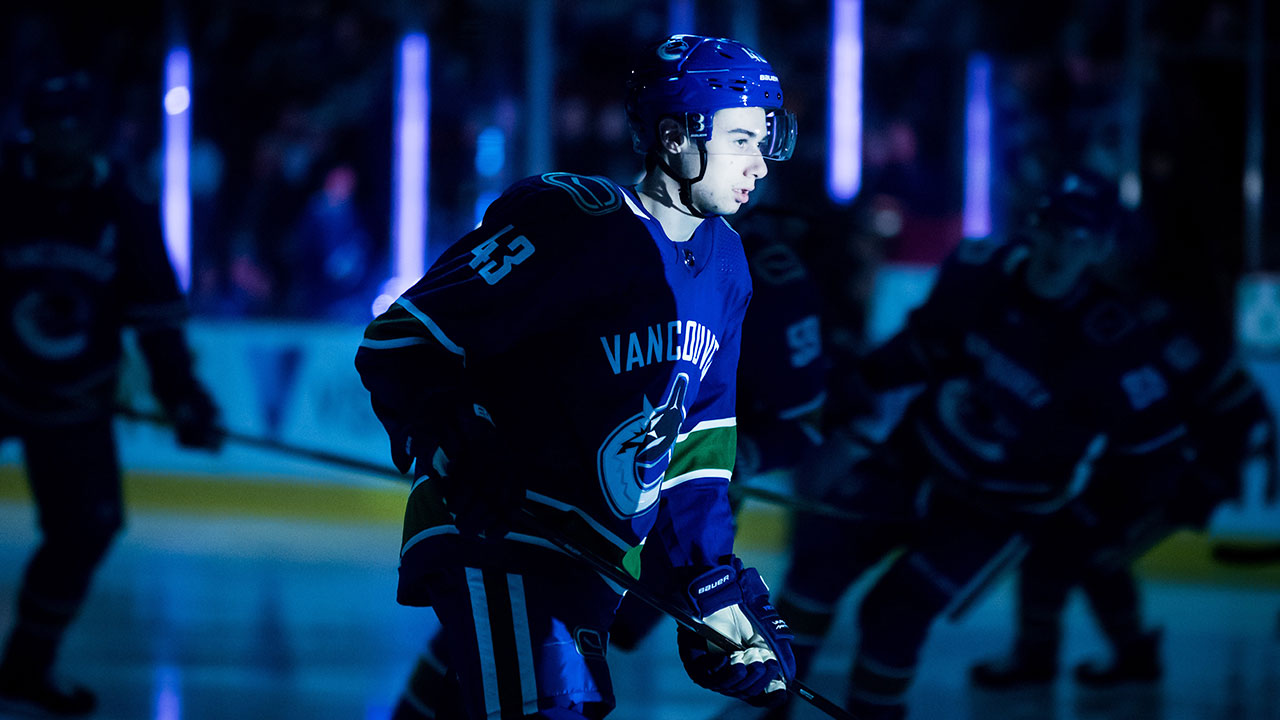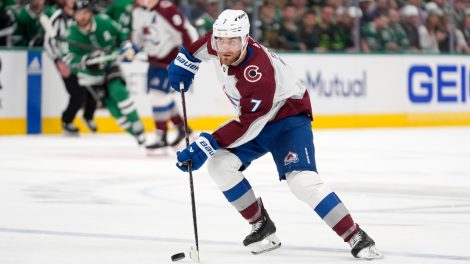— Chris Tanev, on rookie Quinn Hughes, Oct. 4
PHILADELPHIA – Chris Tanev was wrong. Quinn Hughes has done something to surprise us pretty much every game.
The rookie defenceman, who is 20 now but was still a teenager when Tanev said what he said seven weeks ago, has played 23 National Hockey League games this season and been one of the Vancouver Canucks’ best players in about 18 of them.
His agility, puck skills and confidence allow the 5-foot-10 dynamo to do things we haven’t often seen, usually under pressure.
But his track (100-metre dash) and field (javelin) sprint to rescue teammate J.T. Miller and save the Canucks in overtime in Saturday’s 2-1 shootout win against the Washington Capitals was something else again.
When Miller lost the puck to T.J. Oshie inside the Washington blue line, while trying to stickhandle as the last man back, Oshie was at the top of the circles in the middle of the ice, Hughes at the hashmarks near the boards.
In a span of about 130 feet, Hughes made up at least 25 on Oshie — who is not slow — and got close enough to Miller to use his stick to turbo-boost his teammate the last few feet to catch the Capital.
“I thought I could have caught him, honestly,” Hughes said after the game, meaning Oshie, not just Miller.
Teamwork makes the dream work.
Quinn Hughes giving JT Miller a lil boost to catch Oshie on the breakaway in OT is the kind of thing we love to see. #HockeyNight | @Canucks pic.twitter.com/JVvjMjfluk
— Sportsnet (@Sportsnet) November 23, 2019
The only bigger surprise involving Hughes was that the eventual shootout went seven rounds deep and the defenceman didn’t get a turn in any of them.
Hughes finished with a season-high 25:13 of ice time, four shots on net and an assist on Vancouver’s only goal, a power-play rocket by Elias Pettersson.
“Every night he shows us something,” coach Travis Green said. “But tonight he was good in the offensive zone, boy. He was making plays, creating a lot. We had a lot of chances to win it just with some of the plays he made.”
Hughes has 18 points in 23 games, second among NHL rookies behind only Colorado Avalanche defenceman Cale Makar, who had 25 points as of Sunday. In ice time, Hughes’ average of 20:17 trails only Edmonton Oiler blue-liner Ethan Bear.
But in the last seven games, Hughes has averaged 22:07 of ice time – and even that sizeable figure was skewed lower by a 15-minute night Thursday in Nashville when he helped the Canuck power play go five-for-six.
A year ago, Hughes was playing twice a week for the University of Michigan. Now he’s playing every two nights in the NHL.
With Vancouver’s loss Saturday of top defenceman Alex Edler to an undisclosed injury – the Canucks offered no update Sunday on a team day off – Hughes may now have to do even more.
“It’s a lot different, totally different,” Hughes said of the schedule. “I only played Friday-Saturday last year. This makes you have to prepare better and be ready all the time. You could slack off a couple of days at college and do what you want. But here, you’ve got to get your sleep, you’ve got to eat well, stay hydrated. You’ve got to take care of your body and stay focussed.
“It’s hard, but it’s also a treat. You’re not doing long rides on buses. You’ve got the best food, the best travel, everything like that. At the same time, it’s only Game 23. You’ll have to ask me at Game 70 because I could have a different outlook by then. There are 60 more games (this season) in about four more months. That’s crazy.”
[snippet id=4167285]
Hughes figures he played about 60 games last season, all-in. That includes all the games at Michigan, Team USA games at both the world junior and senior championships, and his five-game cameo for the Canucks at the end of last season.
That was 60 games in about eight months. As an NHL rookie, he’ll play about 80 in six months if he stays healthy.
“It’s hard; there’s no getting around it,” Canuck winger Brock Boeser, who made the jump from the University of North Dakota two seasons again, said of the transition to the NHL. “There’s a learning curve. It’s manageable, but there are hard nights. There’s lots of things you can do to make sure your body feels good. But there are some nights where mentally it’s hard to get prepared.”
“I think part of it with young guys is mental sharpness,” Green agreed. “I think (Quinn) is such a good skater, he could probably play three games in a day sometimes. It’s effortless how he skates. But I think it’s the mental part for young guys – being mentally sharp. When you’re not mentally dialled in, sometimes your passes are a foot off or four feet off. The other night (Tuesday in Dallas) he missed a couple of passes. That’s the growing pains that young guys have.”
Playing with Tanev, Hughes has a shots-for percentage of 55.8 this season and an expected goals-for, which measures shot quality, of 59.2. This is at even strength. On the power play, Hughes is already an NHL star.
His 13 power-play points lead all defencemen, one more than Washington’s John Carlson and Boston’s Torey Krug. And Hughes would probably have more had Green not waited seven games before moving the rookie to the first-unit power play alongside Boeser and Pettersson.
The Canucks’ power play is fourth in the NHL at 26.7 per cent, but leads the league with 27 extra-strength goals in 24 games. Vancouver scored only 43 power-play goals all of last season.
“For me, I feel like I should be getting the power play going, and seeing what more can I do offensively and defensively,” Hughes said. “Keep the puck out of my net, and try to make plays.”
He’ll probably do something that surprises everyone Monday against the Philadelphia Flyers.
[relatedlinks]










